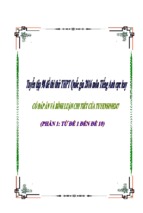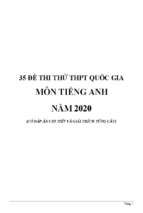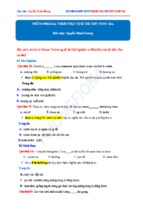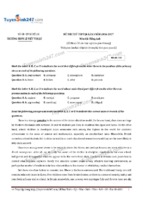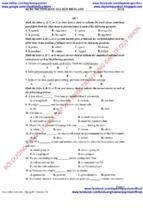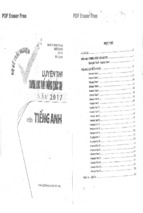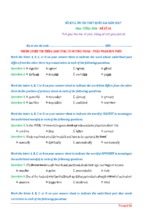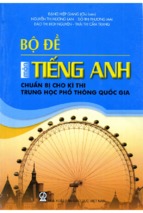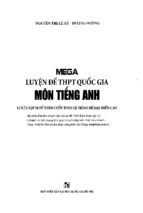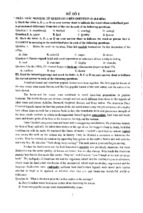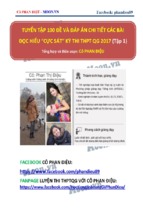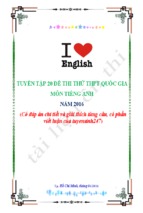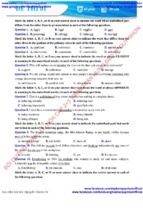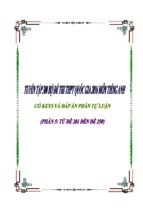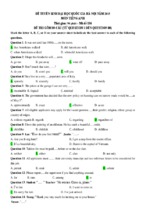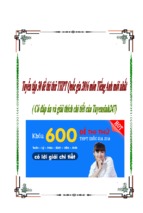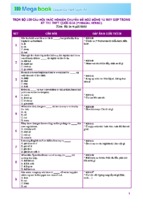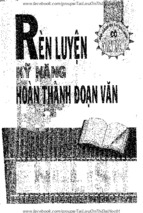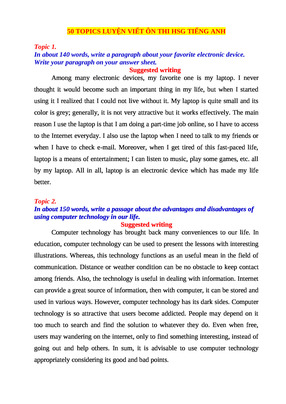CAO THỊ THU GIANG - CAO THỊ HÒNG PHƯƠNG
KHOA TIẾNG ANH - TRƯỜNG ĐH s ư PHẠM HÀ NỘI
Tuyệt phẩm khởi động
KI THI THPT QUỐC GIA
T IẾ È lểA I«
9& T
https://uiuiui.racebaoh.coin/groaps/LuyenThiTMPTquacCiaai/
5
NHÀ XUẤT BẢN TỔNG HƠP THÀNH PHỐ Hồ CHÍ MINH
/líụe J li te
Lời nói đầu
Đề sô" 1: .........................................
3
Đề sô 2 :.............................. £ ...............................................................................23
Đề SỐ3 :.......................... v i . ................................................................................48
Đề sô"4 :.......................
66
Đề số 5 :................
90
Đề sô 6 :.... .......................................................................................................... 111
Đề sô" 7: .u .......................................................................................
135
Đề số 8:.................................................................................y .......................... 157
Đề số 9 :.................................................................... Ợ.......!...............................183
Đề số 10:...........................................................¿ ....y ...................................... 203
Đề số 11 : ...................................................................
230
Đề số 12:........................................x .r ^ Ị ị Z . .................................................253
Đề số 13:.......................................¿.....¿*3........................................................... 278
Đề số 14:............................. .%..........................................................................299
Đề số 15:.............................................................................................................. 325
Đề số 16:...................................................................................................
347
Đề số 17:........................
370
Đề số 18: .....Ị ; ^ V .l ...........................................................U..4....1............... 389
Đề số 19: 3*....... r.............................................................. ................................. 411
Đề số 20:......
439
ì ỹ i p Ị ' j ^ Ị r ị p Ị t a ẩ .lS*#
B
https://iuiuui.Pncefaooh.con^rmms/LuyenThiTIIPTIỊuncCinOI/
lit
Công ty TNHH MTV D W H Khang Việt
ĐỀ SỐ 1
Mark the letter A, B, C, or D on your answer sheet to indicate the word whose
underlined part differs from the other three in pronunciation in each of the
following questions.
Question 1: A. exceed
B. exclaim
C. explanation
D. exploit
Question 2: A. offshoot B. foodstuff
C. crooked
D. foolish
Mark the letter A, B, C, or D on your answer sheet to indicate the word that
differs from the other three in the position of the primary stress in each of the
following questions.
Question 3: A. magnificent B. appliances C. potentially
D. preservation
Question 4: A. architect
B. electric
C. mineral
D. luxury
Question 5: A. influence
B. instructor C. intelligent
D. inflation
Mark the letter A, B, C, or D on your answer sheet to indicate the word or
phrase that is closest in meaning to the underlined part in each of the
following questions.
Question 6: Kent, often called 'the garden of England', and the Vale of Evesham
are famous for horticultural produce.
A. fertilizers and pesticides
B. fruit and flowers
C. chickens and pigs
D. wheat and barley
Question 7: The government provides help for farmers through subsidies which
encourage farmers to produce as much as they could.
A. financial support B. policies
C. regulations
D. taxes
Question 8: British army units are stationed in several countries throughout the world
A. are installed
B. have a spot
C. are pulled down D. have a base
Mark the letter A, B, C, or D on your answer sheet to indicate the word or
phrase that is OPPOSITE in meaning to the underlined part in each of the
following questions.
Question 9: He usually stays in peace in stressful situations but this time he really
lost his head.
A. kept calm
B. excited
C. took leave of his sense
D. lost touch
Question 10: Unless you have been very, very lucky, you have undoubtedly
experienced events in your life that have made you cry.
A. certainly
B. questionably C. absolutely
D. definitely
1 uyêl phaiti khôi dông ky thi THPT Quôc gia Tieng Anli
Mark the letter A, B, C or D to indicate the most suitable option to complete
the sentence
Question 11: Alfonso: “I had a really good time. Thanks for the lovely
evening.”
Maria: “______
A. No, it’s very kind of you
B. Oh, that’s right
C. I’m glad you enjoyed it
D. Yes, it’s really good
Question 12: Roger’s _______are $74 a week.
A. earns
B. earned
C. earning
D. earnings
Question 13: There is no reason to
___his honesty; he is absolutely sincere.
A. believe
B. doubt
C. question
D. ask
Question 14: He couldn’t afford to
______his car repaired.
A. pay
B. make
C. get
D. do
Question 15: The teacher_______
_____her because her mother had just passed away.
A. caught sight of
B. put up with
C. took notice of
D. made allowance for
Question 16: Murder is a serious crime and one rarely gets________ with it.
A. away
B. along
C. off
D. in
Question 17: The camp is a great way of getting kids off the street and keeping
them________trouble.
A. into
B. out of
C. under
D. for
Question 18: - “___
- “He's tall and thin with blue eyes.”
A. Who does John look like?
B. How is John?
C. What does John look like?
D. What does John like?
Question 19: John's score on the test is the highest in the class;________.
A. he should study last night
B. he should have studied last night
C. he must have studied last night
D. he must had to study last night
Question 20: He won’t go home until he_______his report.
A. finished
B. is going to finish
C. will have finished
D. has finished
Question 21: If I had worked harder at school,_______________________
A. I will sit in a comfortable office now.
B. I would be sitting in a comfortable office now.
C. I would have sat in a comfortable office now.
D. I will be sitting in a comfortable office now.
Question 22: I’d rather you_______ in here. There’s a room for smokers out there.
A. wouldn’t smoke B. won’t smoke C. don’t smoke
D. didn’t smoke
uUAAAA V
.A A .
Công ty TNHH MTV D W H Khang Việt
Question 23: Angie warned ________anyone what she had told me.
A. that 1didn’t tell
B. that I told not C. me to tell not D. me not to tell
Question 24:________the rise in unemployment, people still seem to be spending
more.
A. Despite
B. Nevertheless C. Meanwhile
D. Although
Question 25:________did Arthur realize that there was danger.
A. Upon entering the store
B. When he entered the store
C. After he had entered the store
D. Only after entering the store
Question 26: After waiting so long, she couldn’t help________when she heard
the good news.
A. to cry
B. crying
C. be crying
D. to be crying
Question 27: This is the first man__
__ by police yesterday.
A. arrested
B. to arrest
C. to be arrested D. be arrested
Question 28: Why do you always disagree with everything_______ I say?
A. who
B. that
C. when
D. what
Question 29: Their office consisted of three rooms, _________ was used as a
conference room.
A. larger of which
B. the largest of which
C. the largest of them
D. largest
Question 30: “Did Susan ever graduate?”
“No,________in college for two years, she quit to get married.”
A. after having been B. while being
C. since being
D. had she been
9
Question 31: Let’s not go out today, _
A. won’t you
B. shan’t we
C. will you
D. shall we
Question 32: The influence of the nation’s literature, art, and science _
captured widespread attention.
A. have
B. has
C. was
D. were
Question 33: - “Is it all right if I use your bike?”
A. Sure, go ahead. B. I don’t care.
C. I accept it.
D. Oh, forget it.
Question 34: We started early________miss the worst of the traffic.
A. so that
B. in so far
C. in order to
D. as long as
Question 35: The two pairs of shoes are _______ the same color, though
_________different sizes.
A. of/with
B. of/of
C. in/in
D. to/in
5
â U Ị I P
Tuyệt phẩm khởi động kỳ thi THPT Quốc gùi Tiếng Anh
Mark the letter A, B, C or D to show the underlined part that needs correction.
Question 36: Today’s farmers have increased (A) ilk production greatly (B)
through improved (C ) methods of breeding, feeding, and manage (D)dairy cattle.
Question 37: Sitting alone (A) in his (B) room, the strange noise frightened (C)
him (D).
Question 38: When (A)the children are going to visit (B)their grandmother, Henry
and I (C) will be going to(D) Europe.
Question 39: That company sold most sophisticated (A)computer equipment (B)
that (C) we had ever found (D).
Question 40: Among (A)the people present at the bar (B). the police suspected
(C) a thirty-years-old (D)man.
Read the following passage, and mark the letter A, B, C, or D on your answer
sheet to indicate the correct answer to each of the questions.
According to the best evidence gathered by space probes and astronomers, Mars
is an inhospitable planet, more similar to Earth’s Moon than to Earth itself - a dry,
stark, seemingly lifeless world. Mars’ air pressure is equal to Earth’s at an altitude
of 100,000 feet. The air there is 95 percent carbon dioxide.
Mars has no ozone layer to screen out the sun’s lethal radiation. Daytime
temperatures may reach above freezing, but because the planet is blanketed by the
mere wisp of an atmosphere, the heat radiates back into space. Even at the equator,
the temperature drops to -50C (-60F) at night. Today there is no liquid water,
although valleys and channels on the surface show evidence of having been carved
by running water. The polar ice caps are made of frozen water and carbon dioxide,
and water may be frozen in the ground as permafrost.
Despite these difficult conditions, certain scientists believe that there is a
possibility of trans-forming Mars into a more Earth-like planet. Nuclear reactors
might be used to melt frozen gases and eventually build up the atmosphere. This in
turn could create a “greenhouse effect” that would stop heat from radiating back
into space. Liquid water would be thawed to form a polar ocean. Once enough ice
has melted, suitable plants could be introduced to build up the level of oxygen in
the atmosphere so that, in time, the planet would support animal life from Earth
and even permanent human colonies. “This was once thought to be so far in the
future as to be irrelevant,” said Christopher McKay, a research scientist at NASA.
“But now it’s starting to look practical. We could begin work in four or five decades.”
The idea of “terra-forming” Mars, as enthusiasts call it, has its roots in science
fiction. But as researchers develop a more profound understanding of how Earth’s
ecology supports life, they have begun to see how it may be possible to create
similar conditions on Mars. Don’t plan on homesteading on Mars any time soon,
though. The process could take hundreds or even thousands of years to complete
and the cost would be staggering.
Công ty TNHH MTV D W H Khang Việt
Question 41. What is the main idea of the passage?
A. The possibility of changing the Martian environment
B. The challenge of interplanetary travel
C. The advantages of establishing colonies on Mars.
D. The need to study the Martian ecology
Question 42. The word inhospitable in paragraph 1 is closest in meaning to
A.cold
B. generous
C. hostile
D. green
Question 43. The word “there” in paragraph 1 refers to _______
A. a point 100 miles above the Earth
B. the Earth’s Moon
C. Mars
D. outer space
Question 44. Which of the following does the author not list as a characteristic of
the planet Mars that would make colonization difficult?
A. There is little liquid water.
B. Daytime temperatures are dangerously high.
C. The sun’s rays are deadly.
D. Night time temperatures are extremely low.
Question 45. According to the passage, the Martian atmosphere today consists
mainly of_____
A. carbon dioxide B. oxygen
C. ozone
D. water vapour
Question 46. It can be inferred from the passage that the “greenhouse effect”
mentioned in paragraph 3 is_______.
A. the direct result of nuclear reactions
B. the cause of low temperatures on Mars
C. caused by the introduction of green plants
D. a possible means of warming Mars
Question 47. The word "radiating” in paragraph 3 is closest in meaning to______.
A.generating
B. receiving
C. calling
D. gaining
Question 48. According to Christopher McKay, the possibility of transforming
Mars_______.
A. could only occur in science fiction stories
B. will not begin for hundreds, even thousands of years
C. is completely impractical
D. could be started in forty to fifty years
Question 49. The phrase “more profound” in paragraph 4 is closest in meaning to
A.deeper
C. more up-to-date
B. more practical
D. brighter
7
Tuyệt phẩm khởi động kỳ thi THPT Quốc gia Tiếng Anh
Question 50. According to the article, the basic knowledge needed to transform
Mars comes from______.
A.the science of astronomy
B. a knowledge of Earth’s ecology
C. data from space probes
D. science fiction stories
Read the following passage and mark the letter A, B, C, or D on your answer
sheet to indicate the correct answer to complete each of the questions
How men first learnt to (51)_______words is unknown; in other words, the
origin of language is a (52)______. All we really know is that men, unlike animals,
(53) ____ invented certain sounds to express thoughts and feelings, actions and
things so that they could communicate with each other, and that later they agreed
(54) ____ certain signs, called letters, which could be combined to represent
those sounds, and which could be written down. These sounds, (55)______spoken
or written in letters, are called words.
Great writers are those who not only have great thoughts but also express these
thoughts in words that (56)______powerfully to our minds and emotions. This
charming and telling use of words is what we call literary (57)______. Above all,
the real poet is a master of words. He can (58)______his meaning in words which
sing like music, and which by their position and association can (59)______men to
tears. We should, therefore, learn to choose our words carefully, (60)
will make our speech silly and vulgar.
Question 51. A. invent B. create
C. make
D. discover
Question 52. A. story
B. secret
C. mystery
D. legend
Question 53. A. whatever
B. however C. somewhat
D. somehow
Question 54. A. at
B. upon
C. with
D. to
Question 55. A. if
B. however
C. whether
D. though
Question 56. A. interest B. appeal
C. attract
D. lure
Question 57. A. prose B. work
C. form
D. style
Question 58. A. carry
B.convey
C. transfer
D. transmit
Question 59. A. take
B.send
C. break
D. move
Question 60. A. or
B. so
C. although
D. because
Read the following passage, and mark the letter A, B, C, or D on your answer
sheet to indicate the correct answer to each of the questions. (408)
It is said that George Washington was one of the first to realize how important
the building of canals would be to the nation’s development. In fact, before he
became president, he headed the first company in the United States to build a canal
that was to connect the Ohio and Potomac rivers. It was never completed, but it
showed the nation the feasibility of canals. As the country expanded westward,
%
Công ty TNHH MTV D W H Khang Việt
settlers in Western New York, Pennsylvania, and Ohio needed a means to ship
goods. Canals linking natural waterways seemed to offer an effective solution.
In 1791, engineers commissioned by the state of New York investigated the
possibility of a canal between Albany on the Hudson River and Buffalo on Lake
Erie, which would link the Great Lakes area with the Atlantic seacoast. It would
avoid the mountains that served as a barrier to canals from the Delaware and
Potomac rivers.
The first attempt to dig the canal, to be called the Erie Canal, was made by
private companies, but only a comparatively small portion was built before the
project was halted for lack of funds. The cost of the project was an estimated five
million dollars, an enormous amount for those days. There was some on-again, offagain federal funding, but the War of 1812 put an end to this. In 1817, DeWitt
Clinton was elected governor of New York and persuaded the state to finance and
build the Canal. It was completed in 1825, costing two million dollars more than
expected.
The canal rapidly lived up to its sponsor’s faith, quickly paying for itself
through tolls. It was far more economical than any other form of transportation at
the time. It permitted trade between the Great Lake region and East Coast, robbing
the Mississippi River of much of its traffic. It allowed New York to supplant
Boston, Philadelphia, and other eastern cities as the chief center of both domestic
and foreign commerce. Cities sprang up along the Canal. It also contributed in a
number of ways to the North’s victory over the South in the Civil War.
An expansion of the canal was planned in 1849. Increased traffic would
undoubtedly have warranted its construction had it not been for the development of
the railroads.
Question 61. Why does the author most likely mention George Washington in the
first paragraph?
A. He was president at the time the Erie Canal was built.
B. He was involved in the pioneering efforts to build canals.
C. He successfully opened the first canal in the United States.
D. He commissioned engineers to study the possibility of building the Erie Canal.
Question 62. The word “feasibility” in paragraph 1 is closest in meaning to____.
A. profitability
B. difficulty
C. possibility
D. capability
Question 63. According to the passage, the Erie Canal connected the_______.
A. Potomac and Ohio Rivers
B. Hudson River and Lake Erie
C. Delaware and Potomac Rivers
D. Atlantic Ocean and the Hudson river
Question 64. Which of the following is closest in meaning to the word
“comparatively” in paragraph 3 ’
A. relatively
B. contranly
C. incredibly
D. considerably
Question 65. The completion of the Erie Canal was financed by______.
A. the state of New York
B. private companies
C.
D. DeWitt Clinton
5(| the federal government
yc -j,xxxxxx>: xxx: :xxx
Tuyệt phâm khởi động kỳ thi THPT Quốc gia Tiếng Anh
Question 66. The actual cost of building the Erie Canal was_____.
A. five million dollars
B. less than had been estimated
C. seven million dollars
D. more than could be repaid
Question 67. The word “tolls" in paragraph 4 is closest in meaning to_____.
A. jobs
B. grants
C. links
D. fees
Question 68. Which of the following is not given as an effect of the building of the
Erie Canal in the fourth paragraph?
A. It allowed the East Coast to trade with the Great Lakes area.
B. It took water traffic away from the Mississippi River.
C. It helped determined the outcome of the Civil War.
D. It established Boston and Philadelphia as the most important centers of trade.
Question 69. What can be inferred about railroads in 1849 from the information in
the last paragraph?
A. They were being planned but had not yet been built.
B. They were seriously underdeveloped.
C. They had begun to compete with the Erie Canal for traffic.
D. They were weaken by the expansion of the Canal.
Question 70. The word “it” in paragraph 4 refers to_____.
A. the Mississippi river
B. the canal
C. the sponsor
D. East Coast
Mark the letter A, B, C or D to indicate the sentence that is closest in meaning
to each of the following questions.
Question 71. John’s father used to work for a well-established bank.
A. John’s father is now a staff of a well-established bank.
B. John’s father no works for a well-established bank longer.
C. John’s father does not work for a well-established bank longer.
D. John’s father does not work for a well-established bank any longer.
Question 7 2 .1 am sure that you dropped your wallet at the bus stop.
A. You must drop your wallet at the bus stop.
B. You should have dropped your wallet at the bus stop.
C. You must have dropped your wallet at the bus stop.
D. You should drop your wallet at the bus stop.
Question 73. People believe that that boy took Peter’s money.
A. That boy is believed to have taken Peter’s money.
B. It is believed for that boy to take Peter’s money.
C. That boy is believe to take Peter’s money.
D. That boy is believed that he took Peter’s money.
%
Công ty TNHH MTV DVVH Khang Việt
Question 74. It was such a good play that the audience cheered.
A. The play was too good for the audience to cheer.
B. So good was the play that the audience cheered.
C. It was so good play that the audience cheered.
D. Such was good play that the audience cheered.
Question 75. The bank manager advised George to open a savings account.
A. If the bank manager advised George, he would open a savings account.
B. George were forced to open a savings account by the bank manager.
C. “If I were you, I would open a savings account,” said the bank manager.
D. George was allowed to open a savings account by the bank manager.
Mark the letter A, B, C, or D on your answer sheet to indicate the sentence
that best combines each pair of sentences in the following questions.
Question 7 6.1 will take you to the town. I grew up in that town.
A. I will take you to the town where I grew up in.
B. I will take you to the town in which I grew up.
C. I will take you to the town in where I grew up.
D. I will take you to the town I grew up in which.
Question 7 7 .1broke my mother’s glasses. I said sorry to her.
A. I apologized my mother because I had broken her glasses.
B. I apologized my mother as breaking her glasses.
C. I apologized to my mother for breaking her glasses.
D. I felt sorry for my mother’s breaking her glasses.
Question 7 8 .1 met the head of that club several years ago. I remember this.
A. I remember meeting the head of that club several years ago.
B. I remember to meet the head of that club several years ago.
C. I remember for meeting the head of that club several years ago.
D. I remember to be met by the head of that club several years ago.
Question 79. John doesn’t care for modern art. Bob doesn’t, either.
A. Both John and Bob care for modern art.
B. Neither John or Bob cares for modern art.
C. Either John or Bob cares for modern art.
D. Neither John nor Bob cares for modern art.
Question 80.1sold the house last year. That’s why I am living in my friend’s house.
A. If I had not sold the house last year, I would not have lived in my friend’s house.
B. If I didn’t sell the house last year, I would not be living in my friend’s house.
C. If I had not sold the house last year, I would not live in my friend’s house.
D. If I had not sold the house last year, I would not be living in my friend’s house.
^
Xj
J
ffl Axxxx
^
. ^
! 5ftC 5V>iv
^
^
J£ X X JC X X X
X X X X jX X X X
i iX X X X M M
11
ỊIM IP
Tuyệt phẩm khởi động kỳ thi THPT Quốc gia Tiếng Anh
ĐÁP ÁN
Question 1: Đáp án C: explanation có phiên âm là: /.eksplo'neijh/
Các phương án khác, phần gạch chân đều có phiên âm là /ik /
A. exceed /ik'si:d/
B. exclaim /ik'skleim /
D. exploit /ik 'sp b it/
Question 2: Đáp án C: crooked có phiên âm là: /'krukid/
/u /
Các phương án khác, phần gạch chân đều có phiên âm là / u : /
A. offshoot /'o:f|u:t/
B.
foodstuff
/'fu:dstAf/
D. foolish /'fu:lijy
Question 3: Đáp án D: preservation: /'prezo:'veiJh/ trọng âm vào âm tiết thứ ba
Các phương án khác trọng âm đều rơi vào âm tiết thứ hai
A. magnificent /maeg'nifisnt/
B. appliances /a'plaionsiz/
c. potentially /po'tenjoli/
Question 4: Đáp án B: electric / i'lektrik/: trọng âm rơi vào âm tiết thứ hai
Các phương án còn lại trọng âm rơi vào âm tiết thứ nhất.
A. architect /'cukitekt/
C. mineral /'m inorol/
D. luxury / ’lAk/ori/
Question 5: Đáp án A: Influence / ‘influans/: trọng âm vào âm tiết thứ nhất.
Các phương án còn lại trọng âm rơi vào âm tiết thứ hai
B. Instructor /in'strA kta/
D. Inflation /m 'fleijh/ 1 0
Question 6: Đáp án B: fruit and flowers
c. Intelligent /in'teli(^ant/
f \ v
Horticultural ~ fruit and flowers', sản phâm nhà vườn hoặc làm vườn mà ra.
Nghĩa của câu: Kent, thường được gọi là “khu vườn của nước Anh”, và Vale of
Evesham nối tiếng vì có các sản phấm nhà vườn.
Question 7:
Đáp án A: financial support
Subsidy = financial support: tiền trợ cấp hoặc ữợ giá cùa chính phù cho một
ngành hoặc một sản phẩm.
Nghĩa cùa câu: chính phu trợ cấp cho nông dân thông qua chương trình trợ giá
< ^ k ^ ^ ế |k h í ^ h ọ ^ ^ ^ u ^ n h i ^ i . ^ x x ^
Công ty TNHH MTV DVVH Khang Việt
Question 8: Đáp án D: have a base: Be stationed ~ have a base: đặt căn cứ/hoặc
cơ sờ ở nơi nào đó.
Nghĩa của câu: Các đơn vị quân đội Anh đặt căn cứ ờ vài quốc gia trên toàn thế giới.
Question 9: Đáp án A. kept calm: To lose one’s head: mat bình tĩnh >< to keep
calm: giữ bình tĩnh.
Nghĩa cùa câu: Anh ấy luôn giữ được bình tĩnh trong những hoàn cảnh căng
thăng, nhưng lần này anh ấy lại mất bình tĩnh.
Question 10: Đáp án B. questionably: Undoubtedly: không nghi ngờ gì ><
questionably: đáng ngờ.
Nghĩa cùa câu: Neu bạn đã không may mắn, không còn nghi ngờ gì việc (chắc
chắn) bạn đã phải khóc khi bạn trải nghiệm sự kiện này trong đời.
Question 11: Đáp án c. Fm glad you enjoyed it.
Nghĩa cùa câu: Alfonso: "Mình thực sự rất vui. Cảm ơn ve một buôi tối thú vị. ”
Maria: "Mình rát mừng là bạn thích nó ”.
Question 12: Đáp án D. earnings: Chỗ ưống cần một danh từ vì theo sau dấu sở
hữu cách nên loại phương án A và B.
Ta có earnings: sổ tiền kiếm được.
Nghĩa của câu: So tiền mà Roger kiếm được trong một tuần là 74 đô la.
Question 13: Đáp án B. doubt: To doubt one’s honesty: nghi ngờ sự trung thực
của ai.
Nghĩa của câu: Không có li do gỉ đê nghi ngờ tinh trung thực cùa anh ta. Anh ta
thực sự thật thà.
Các phương án A, c và D đều không hợp nghĩa với câu thứ hai.
Question 14: Đáp án c. get:
Ta thấy động từ sau his car ớ dạng phân từ hai. Đây là một cấu trúc bị động cũa
câu sai khiến, nhờ vả. Get something +Pịi: thuê/nhờ người làm việc gì.
Nghĩa của câu: Anh ấy không đù tiên đê thuê người sữa xe.
Question 15: Đáp án D. made allowance for
Make allowance for somebody: chiếu CO (đế ý và giúp đỡ) đến ai.
Nghĩa của câu: Cô giáo quan tám đèn cô ây vì mẹ cô ây mới qua đời.
Phương án A: to catch sigh of sb: nhìn thấy ai -> không hợp nghĩa.
Phương án B: to put up with: chiu đựng-> không hợp nghĩa.
Phương án C: to take notice of sb: để ý/quan tâm tới ai, nhưng trong trường hợp
này phương án c thiếu giới từ of.
13
1 uyệi pliant khởi động kỳ thi THPT Quốc gia Tiếng Anh
Nghĩa cùa câu: Tội giêt ngirời là một tội nghiêm trọng, và hiêm có ai thoát khói
tội nàv.
Phương án B: to get along with: thân thiện với ai. -> không hợp nghĩa.
Phương án C: to get off with: cặp được với ai trong bữa tiệc hoặc buồi nhảy.
-> không hợp nghĩa.
Phương án D: to get in with: thân thiện với ai. -> không hợp nghĩa.
Question 17: Đáp án B. out of: to keep sb out of trouble: giữ cho ai không gặp rắc
rối/có chuyện xấu xáy ra.
Nghĩa cùa câu: Trại hè ĩằ một cách hay đê bọn trẻ tránh khỏi đường phô và giữ
cho chúng không gặp răc rỏi.
Phương án A: to keep into trouble: vô nghĩa.
Phương án C: to keep under trouble: vô nghĩa.
Phương án D: to keep for trouble: vô nghĩa.
Question 18: Đáp án c . What does John look like?
Câu hởi với What + trợ không hợp với nghĩa với câu trước.
Phương án D: sai cấu trúc.
Phương án C: cấu trúc must have + P||: Chắc hãn toi qua anh ta đã học bài.
-> hợp với nghĩa câu trước.
Question 20: Đáp án D. has finished:
Nghĩa cùa câu: Anh ta sẽ không về nhà cho đên khi hoàn thành bán báo cáo.
Theo cách phối hợp về thì của hai mệnh đề (gồm mệnh đề chinh và một mệnh
đề trạng ngữ chỉ thời gian): Mệnh đề He won 't go home —mệnh đề chính ờ thì
tương lai
=> mệnh đề trạng ngữ chỉ thời gian ờ thì hiện tại đơn hoặc hiện tại hoàn thành.
Question 21: Đáp án B. I would be sitting in a comfortable office now.
C
/,xx*w
^k,
X XX X5
Công ty TNHH MTV D W H Khang Việt
Ta thấy mệnh đề if đã cho là một về của câu điều kiện loại 3 —> Phương án B
(loại 2, 3kết hợp) và c (loại 3) có thể chọn được.
Tuy nhiên mệnh đề chính ờ hai phương án B và c có từ now - bây giờ. Đây là
một giá thuyết về kết quả ớ hiện tại (chứ không phái kết quá ở quá khứ như điều
kiện loại 3) —> đây là câu điều kiện kết hợp loại 2 và 3.
Nghĩa của câu: Nêu ờ trường tôi học tập chăm chỉ hơn thì giờ này tôi đang làm
việc trong một văn phòng tiện nghi roi.
Question 22: Đáp án D. didn’t smoke:
Vì theo cấu trúc would rather somebody + V ở quá khứ đơn (phu định dùng trợ
động từ did): muốn ai đó làm/không làm việc gì.
Nghĩa của câu: Tôi không muôn anh hút thuóc ớ đâv. Có một phòng dành cho
những người hút thuôc ở đăng kia.
Question 23: Đáp án D. me not to tell:
Vì theo cấu trúc: to warn sb not to do sth: cảnh cáo ai không được làm gì
Nghĩa của câu: Angie đã cánh cáo tỏi không được kê cho bât kỳ’ ai biêt những gì
mà cô âv đã cho tói biêt.
Question 24: Đáp án A. Despite:
Vì the rise in unemployment là cụm danh từ nên ta chọn despite (mặc dù).
Nghĩa của câu: Mặc dù tình trạng thát nghiệp ngày càng tăng, nhưng người ta
dường như vân chi tiêu nhiêu hơn.
Question 25: Đáp án D. Only after entering the store:
Nhìn vào đề bài đã cho có trợ động từ did đứng trước chù ngữ Arthur —» câu
đảo ngữ, và chi có cấu trúc Onlv after Ving sth + mệnh đề ở dạng đáo ngừ.
Question 26: Đáp án B. crying:
Động từ help có 2 cấu trúc: to help sb to do sth: giúp ai làm gì và can 't help
doing sth: không thể ngừng làm gì. Theo nghĩa cùa câu ta chọn phương án B.
Nghĩa cùa câu: Sau khi đã đợi quá lâu, cỏ ây không tài nào ngừng khóc được
khi nghe được tin vui đó.
Question 27: Đáp án c . to be arrested:
Sau cấu trúc This/that is the íirsưsecond/lasưonly + noun + to Vnt. Neu ở bị
động thì cấu trúc sẽ là: This/that is the íìrsưsecond/lasưonly + noun + to be P ii
Nghĩa của câu: Đâv là người đàn ông đâu tiên bị cảnh sát băt ngày hỏm qua.
Question 28: Đáp án B. that:
x x x x x x xx x :
:xxx
tuyệt phẩm khởi động kỳ thi THPT Quốc gia Tiếng Anh
Đại từ quan hệ that được dùng sau các đại từ phiếm chỉ như all, some, anything,
nothing, everything...
Nghĩa của câu: Tại sao anh không đông ỷ với mọi điêu tôi nói?
Question 29: Đáp án B. the largest of which:
Theo đề bài có three rooms - 3 căn phòng, vế thứ hai nói về căn phòng lớn nhất
trong 3 căn. —> dùng so sánh hơn nhất với the + adị ở so sánh hom nhất + o f
which (chứ không được dùng of them).
Nghĩa của câu: Văn phòng cùa họ gồm 3 phòng, căn lớn nhất được dùng làm
phòng họp.
Question 30: Đáp án A. after having been:
Chỗ trống là dạng rút gọn của mệnh đề trạng ngữ chỉ thời gian với dạng đầy đủ
là: after she had been in college for two years.
Nghĩa của câu: “Susan đã tót nghiệp chưa?’’“Chưa, sau khi học được hai năm,
cô âv bỏ ngang đê lập gia đình ”,
Phương án B: Neu câu gốc là: while she was in college (và không có for two
years) thì có thế rút gọn thành while being.
Phương án c. sai cấu trúc.
Phương án D. had she been = if she had been, tuy nhiên mệnh đề sau sai cấu
trúc điều kiện loại 3.
Question 31: Đáp án D. shall we:
Câu hỏi đuôi của câu rủ let's (not) do sth có dạng Sliall/Shan 't we.
Theo đề bài, mệnh đề cúa câu rủ ở phũ định nên câu hỏi đuôi là Shall we.
Nghĩa của câu: Hóm nay chúng ta không đi chơi được không?
Question 32: Đáp án B. has:
Chủ ngữ cũa câu là the influence - sự ảnh hường - là danh từ không đếm được
nên động từ chia số ít. Theo ý nghĩa câu đề: Anh hướng cùa văn học, nghệ thuật
và khoa học quóc gia đã thu hút được sự quan tâm rộng rãi —>câu chú động.
Question 33: Đáp án A. Sure, go ahead:
Nghĩa của câu: - “Sẽ không sao nếu mình dùng xe đạp của cậu chứ?
- “Chác chăn rôi, cậu cứ tự nhiên. ”
Question 34: Đáp án c . in order to:
in order to + Vnt: để làm việc gì (chỉ mục đích).
Còn so that và as long as đi trước mệnh đề (S-V).
Nghĩa của câu: Chúng tôi khởi hành sớm đê tránh giao thòng tồi tệ.
Question 35: Đáp án B. of/of:
,A A .
T
Công ty TNHH MTV D W H Khang Việt
Câu trúc be o f the same color: cùng màu; be o f different sizes: khác kích cỡ.
Nghĩa của câu: Hai đôi giàv cùng màu sắc mặc dù khác nhau về kích cỡ.
Question 36: Đáp án D. Sứa lại thành: managing vì theo cấu trúc song song, động
từ manage nằm trong chuỗi các động từ Ving như breeding, feeding đứng sau
giới từ of.
Through improved methods of breeding, feeding and managing dairy cattle:
thông qua các phương pháp tiến bộ về gây giống, nuôi dưỡng và sử dụng vật
nuôi sán xuất bơ sữa.
Improved trong trường họp này là tính từ ờ dạng phân từ hai bố nghĩa cho danh
từ methods.
Question 37: Đáp án A. Sừa lại thành: When he was sitting alone.
Theo đề bài, sitting alone được rút gọn thành dạng Ving và là hành động cùa
một người nào đó (ngồi một minh). Tuy nhiên, chủ ngữ cua mệnh đề thử hai là
the strange noise (chì vật). Hai mệnh đề không cùng một chú ngữ nên không thể
rút gọn như phương án A được.
Question 38: Đáp án B. Sửa lại thành: visit. Theo sự kết họp giữa các thì, mệnh đề
chính ở thì tương lai thì mệnh đề trạng ngữ chi thời gian sẽ ở thì hiện tại. Mà
phương án B ớ thì tương lai gần —> B sai.
Question 39: Đáp án A. Sửa lại thành the most sophisticated. So sánh hơn nhất
của tính từ phái có mạo từ the đi kèm trước tính từ.
Question 40: Đáp án D. Sứa lại thành thirty-year-old. Khi một cụm từ có chứa từ
chỉ số lượng có chức năng như một tính từ thì danh từ nằm trong cụm từ phài đế
ở số ít. Ví dụ khác như: three storey house: ngôi nhà ba tầng.
Question 41: Đáp án A. The possibility of changing the Martian environment
(Khả năng thay đôi môi trường trên sao hoá) vì ỷ chính này có thể được tìm
thấy qua câu đầu tiên cùa mỗi đoạn.
Đoạn 1 và 2 nói về các đặc điếm sao Hoả, còn đoạn 3 và 4 nói về các lý do cho
thấy có khả năng thay đối môi trường trên sao Hoả.
Các phương án còn lại không phù họp về nghĩa.
Phương án B. Khó khăn cùa việc đi lại giữa các hành tinh.
Phương án c. Những thuận lợi của việc thiết lập các khu vực dân cư trên sao Hoà.
Phương án D. Sự cần thiết phái nghiên cứu hệ sinh thái trên sao Hoà.
Question 42: Đáp án c . hostile (khắc nghiệt) vì nghĩa của từ inhospitable được
làm rõ qua phần giải thích ở sau dấu gạch ngang với 2 từ dry (khô hạn) và
ldelepjkhóng có sựj W ) . VI thế tó hjeyiphospitaWe cónglña
9c TỊ,
ÍTJOOC
jí' 9? Jfcxxxxx
x;
17
11 uujiiJUuưư
Tuyệt phẩm khởi động kỳ thi THPT Quốc gia Tiêng Anh
Question 43: Đáp án c . Mars (sao Hoả)
Question 44: Đáp án B. Daytime temperatures are dangerously high. (Nhiệt độ
ban ngày cao một cách hết sức nguy hiếm)
Đây là câu hói về một đặc điếm của sao Hoà làm cho việc sinh sống khó khăn
mà không có trong nội dung bài đọc. Thông tin về sự xuất hiện cùa nước trên
sao Hoá được nhắc đến ờ chỗ “the surface show evidence of having been carved
by running water” (be mặt cho thấy dấu hiệu bị bào mòn bới nước cháy). Thông
tin về việc các tia mặt trời rất nguy hiếm nằm ở chỗ “the sun’s lethal radiation”
- bức xạ nguy hiểm chết người của mặt trời. Thông tin về nhiệt độ vào ban đêm
nằm ở chồ “the temperature drops to -50C (-60F) at night” - nhiệt độ rơi xuống
âm 50 độ c vào ban đêm. Như vậy chỉ có thông tin B. là không được đề cập đến
trong bài đọc.
Question 45: Dáp án A. carbon dioxide (khí C 0 2) vì theo nội dung bài đọc thì
“The air there is 95 percent carbon dioxide” - không khí trên đó có 95% là khí
C 02. Như vậy bầu khí quyến trên sao Hoả chủ yếu có khí C 0 2.
Question 46: Đáp án D. a possible means of warming Mars.
(một phương pháp làm nóng sao Hoá có thề xây ra).
Đây là câu hởi suy luận, và từ những thông tin trong bài về hiệu ứng nhà kinh
rang “would stop heat from radiating back into space” - hiệu ứng nhà kinh sẽ
ngăn không cho hơi nóng quay trờ lại vũ trụ, vì thế mà sẽ làm sao Hoá ấm lên vì
hơi nóng không thoát đi được.
Các phương án còn lại đều sai về nghĩa hoặc không thể suy luận ra từ nội dung
bài đọc.
Question 47: Đáp án A. generating (tạo ra)
Question 48. Đáp án D. could be started in forty to fifty years (có thê được khởi
động trong vòng 40 đến 50 năm nữa).
Theo Christopher McKay nói thì “We could begin work in four or five decades”
- chúng ta CÓ the bat đầu công việc (thay đổi sao Hoả) trong 4 hoặc 5 thập kỷ
nữa. Như vậy khá năng thay đối sao Hoá có thể diễn ra trong 40 đến 50 năm nữa.
Question 49: Đáp án A. deeper (sâu hơn) vì nghTa của từ more profound được
hiểu như vậy vì nó bố nghĩa cho danh từ understanding (sự hiểu biết) và qua
cụm từ “scientists develop” - các nhà khoa học phát triến. Như vậy ta nên hiếu
more profound là hiểu biết thêm, đầy đú hơn nữa về sao Hoá.
Question 50: Đáp án B. a knowledge of Earth’s ecology (kiến thức về hệ sinh thái
của trái đất) vì theo nội dung bài đọc thì kiến thức cơ bản cần phải có đế thay
đồi sao Hoả bắt nguồn từ “understanding how Earth’s ecology supports life” XXKXg
Công ty TNHH MTV D W H Khang Việt
Question 51: Đáp án A. invent (tạo ra) vì nghĩa của từ này được làm rõ qua cụm
từ “in other words” - hay nói cách khác thì và cụm danh từ “the origin of
language (nguồn gốc cùa ngôn ngữ). Như vậy đế nói về nguồn gốc của một cái
gì đó, chính là tim hiếu về sự phát minh ra nó.
Question 52: Đáp án c . mystery (điều bí ấn) vì nghía của từ này được làm rõ
nghĩa qua từ unknown (không biết).
Question 53: Đáp án D. somehow (phần nào) vì ta cần một trạng từ bổ nghĩa cho
động từ invented. Trong các phương án đưa cho thì chi có D là trạng từ bố
nghĩa cho động từ.
Question 54: Đáp án B. upon vì agree on something có nghĩa là đồng ý với nhau
về cái gỉ (agree on = agree upon).
Question 55: Đáp án c . whether (dù) vì ta có cấu trúc “whether ....or..” - dù thế
này hay thế kia.
Question 56: Đáp án B. appeal (thu hút) vì ta có cấu trúc appeal to. Ớ các phương
án còn lại, động từ không kết hợp với giới từ “to”.
Question 57: Đáp án D. style (phong cách) vì nghĩa cùa từ này được làm rõ qua
định nghĩa phía trước “This charming and telling use of words” - “Cách sử
dụng từ lôi cuốn và hiệu quá này” và qua tính từ “literary” - thuộc về văn học.
Vì thế cách sử dụng từ chính là phong cách.
Question 58: Đáp án B. convey (fruyen tái một thông điệp) vì nghĩa cũa động từ
này được làm rõ qua cụm từ kết hợp —meaning in words (nghĩa qua từ ngữ). Ta
có cấu trúc convey a meaning có nghĩa là truyền tải nghĩa.
Question 59: Đáp án D. move vỉ ta có cấu trúc move somebody to tears có nghĩa
là làm cho ai đó cảm động rơi nước mắt.
Question 60. Đáp án A. or vì liên từ này dùng để chi một hệ quả trái ngược qua
các từ “choose our words carefully” - chọn từ một cách cẩn thận và “will make
our speech silly” —sẽ làm lời nói của chúng ta thành ngớ ngấn và “or” trong câu
này mang nghĩa là nếu không thì.
Question 61. Đáp án B. He was involved in the pioneering efforts to build canals.
(Ông tham gia vào những nỗ lực tiên phong xây dựng các kênh đào.)
Tác giá nhắc đến George Washington vì “It is said that George Washington was
one of the first to realize how important the building of canals would be to the
nation’s development” —người ta nói rang George Washington là một trong
những người đầu tiên nhận ra việc xây dựng các kênh đào quan trọng như thế
nào đối với sự phát triên của đất nước.
Question 62: Đáp án c . possibility (sự khá thi)
Nghĩa cùa từ feasibility được làm rõ qua liên từ “but” nối 2 ý “never
completed” - không bao giờ được hoàn thành nhưng “showed the nation the
feasibility of canals” - cho cá nước thấy tiềm năng của các kênh đào. Vì thế
feasibility nên được hiểu là tiềm năng hoặc tính khá thi.
x;
.- X V
ex
x:
*
XX
XX
:x
. vX ỉ x x x x a
XX
J ỉ
yc
19
ATTuyệt
HOMELESS
.. . . . . . . . . . . . .
phăin khởi động kỳ thi THPT Quốc gia Tiếng Anh
Question 63: Đáp án B. Hudson River and Lake Erie vì thông tin về kênh đào Erie
nổi nơi nào với nơi nào nằm ở chỗ “a canal between Albany on the Hudson
River and Buffalo on Lake Erie” —một kênh đào giữa Albany bên bờ sông
Hudson và Buffalo bên ho Erie.
Question 64: Đáp án A. relatively (tương đối) vi trạng từ comparatively bố nghĩa
cho tính từ small nên ta hiểu đó là trạng từ chỉ mức độ - hơi, khá là, tương đối.
Nghĩa này được làm rõ qua cụm từ “project was halted for lack of funds” - dự
án này bị dừng lại do thiếu quỹ.
Question 65: Đáp án A. the State of New York (bang New York). Thông tin ve
nguồn von đế giúp việc xây dựng kênh đào Erie nằm ở chỗ “In 1817, DeWitt
Clinton was elected governor of New York and persuaded the state to finance
and build the Canal. It was completed in 1825” - Vào năm 1817, DeWitt
Clinton được bầu làm thong doc bang New York và ông đã thuyết phục bang
cấp tiền xây dựng kênh đào Erie. Kênh đào được hoàn thành vào năm 1825.
Question 66: Đáp án C. seven million dollars (7 triệu đô la)
Thông tin về chi phí thực tế xây dựng kênh đào Erie nam ở chỗ “costing two
million dollars more than expected” (ton nhiều hơn dự kiến 2 triệu đô la) và
“The cost of the project was an estimated five million dollars” (chi phí của dự
án được dự tính là 5 triệu đô la). Như vậy tồng chi phí là 7 triệu đô la.
Question 67: Đáp án D. fees (các khoán phí)
Nghĩa của từ tolls được làm rõ qua cụm từ “paying for itself through”- tự trả
tiền cho mình qua các loại phí.
Question 68: Đáp án D. It established Boston and Philadelphia as the most
important centers of trade (Nó đã giúp Boston và Philadelphia trơ thành những
trung tâm thương mại quan trọng nhất). Thông tin về ảnh hướng của việc xây
dựng kênh đào Erie “It allowed New York to supplant Boston, Philadelphia, and
other eastern cities as the chief center of both domestic and foreign commerce.”
- Nó đã giúp New York vượt xa Boston, Philadelphia và các thành phố phía
đông khác và trơ thành trung tâm chính về giao thương trong nước và quốc tế.
Question 69: Phuong án c . They had begun to compete with the Erie Canal for
traffic. (Các tuyến đường sat đã bat đầu cạnh tranh với kênh đào Erie về các
phương tiện lưu thông).
Thông tin cho câu hỏi suy luận về các tuyến đường sắt vào năm 1849 nam ở chỗ
“Increased traffic would undoubtedly have warranted its construction had it not
been for the development of the railroads.” - Xe cộ tăng lên chắc chan đã đảm
báo cho việc mở rộng kênh đào Erie nếu như không có sự phát triển của các
tuyến đường sắt. Như vậy ta hiếu là sự phát triển cùa ngành đường sắt đã ảnh
hướng đến sự phát triển của kênh đào Erie.
Question 70: Đáp án B. the canal (kênh đào)
'AXX*w
^k,
20
C
X XX X5
- Xem thêm -


